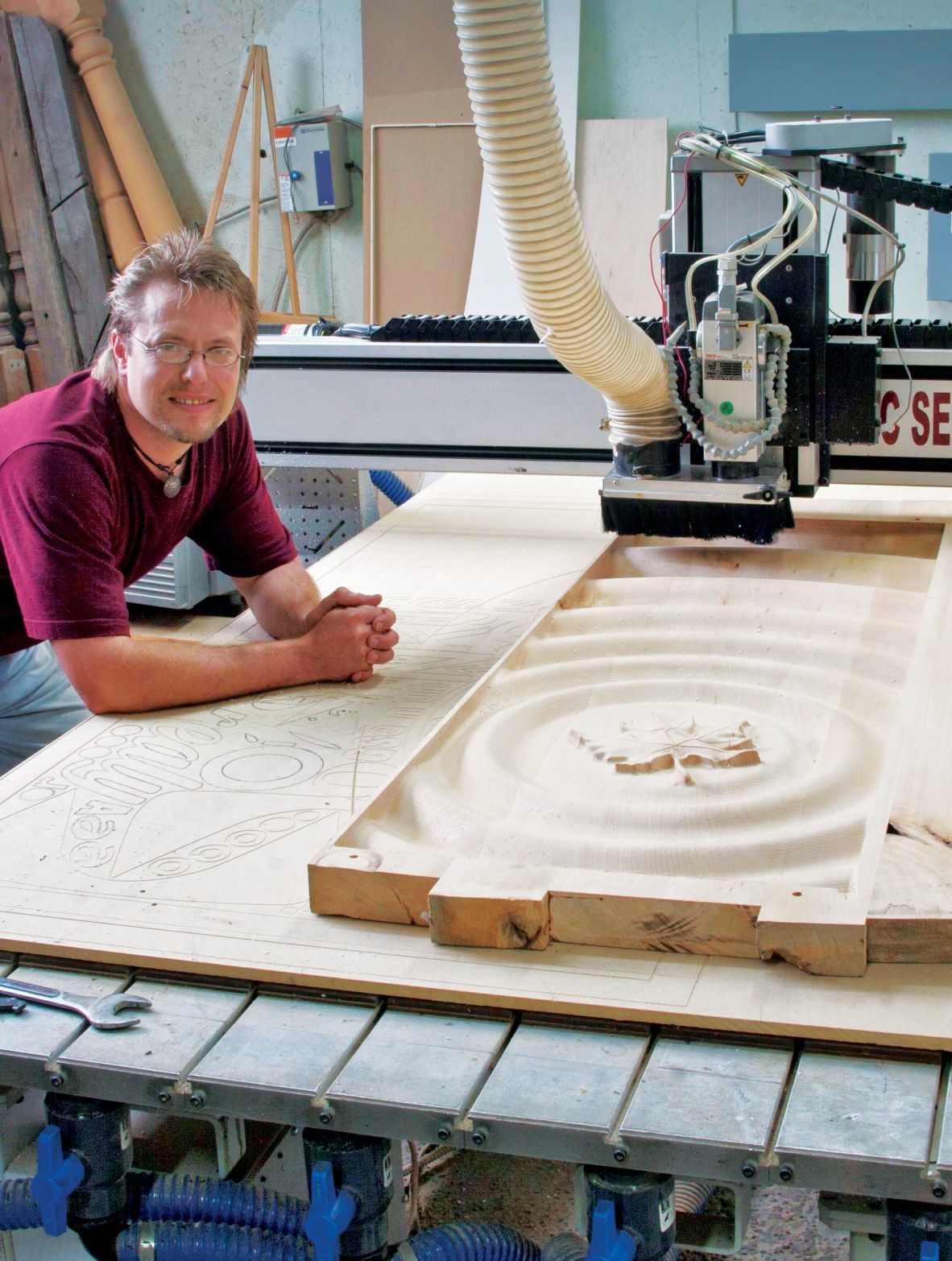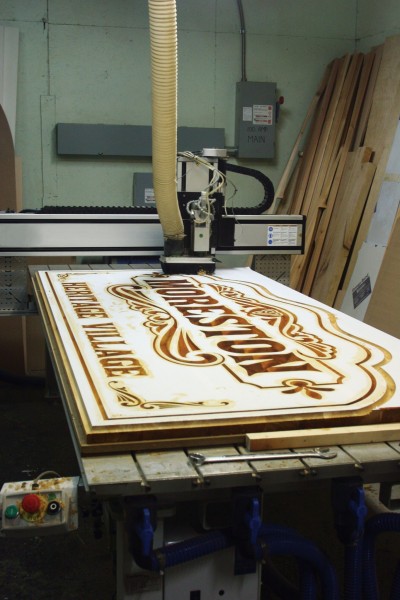Sign Shop Profile: Nicholson Design
by all | 5 January 2013 8:30 am
 [1]By Jerry Fireman
[1]By Jerry Fireman
Grant Nicholson, who currently runs Nicholson Design in Owen Sound, Ont., worked as a graphic designer for more than 20 years. After he built his own house, however, he decided he was tired of working only with software.
Instead, he looked for tools that would allow him to turn design concepts into physical objects by himself. He decided to purchase a computer numerical control (CNC) router to produce dimensional signs and other objects, working with natural materials, such as wood. He has now operated it for three years.
Today, Nicholson’s in-house capabilities for producing complex, three-dimensional (3-D) signs cannot easily be matched by his local competitors.
“The router has helped me rise to the cream of the crop in the sign business in my region,” he says. “It pays for itself every year by increasing the quality of my work and reducing the amount of time required to produce it.”
He also uses it for a wide range of woodworking purposes, creating everything from wooden floor inlays to newels for stairposts (the ornamental first posts at the bottom of a stairway).
“I think of it as a ‘virtual chisel,’” he says.
 [2]Envisioning arts
[2]Envisioning arts
Nicholson earned a visual arts degree in 1992. Since then, he has worked for both small and large companies, including Transcontinental Printing and Quebecor Printing. He also spent nine years working for a local government agency, designing signs, publications, museum exhibits and tourism promotions. That was just before he started his own firm.
“The availability of economical CNC machines with the ability to produce finely detailed work was a big factor in encouraging me to strike out on my own, considering how labour-intensive the process used to be,” he says. “The great sculptors had teams of assistants who would carve out basic forms. The sculptors supervised their work and made the finishing touches. In modern times, we cannot afford these teams of people, yet we yearn for beautiful work that is not mass-produced, but rather matched to our individual tastes.”
As Nicholson started planning his business, he considered several potential production methods. He looked at waterjet and plasma cutting, for example, but did not want to be constrained to producing two-dimensional (2-D) objects. He liked how 3-D printing could produce an endless variety of shapes, but it was limited to a few different types of plastic.
CNC routers, on the other hand, combined the abilities to produce 3-D objects and to work with nearly any type of plastic, foam, wood and synthetic wood.
“So, I looked at a number of different routers,” he says. “Maintenance and reliability were my biggest concerns. I was afraid if the machine broke down, my new business would die!”
After meetings and demos, Nicholson had confidence in the reliability of the device he ended up purchasing.
Today, he says the machine has lived up to its promise and been “incredibly reliable.”
“It has never required any service and has had almost no downtime in the three years of operation,” he says.
 [3]Success through accessories
[3]Success through accessories
Nicholson also purchased and added on a variety of accessories, including a micro-drop head that sprays fine droplets of coolant onto his work. This is needed when cutting non-ferrous materials, such as aluminum and brass.
Particularly key to his success has been a vacuum table, which saves time by avoiding the need to clamp down every piece he cuts with the router.
“I might cut out 200 letters in one setup of the machine,” he explains. “It would be a nightmare to clamp down each of them in place. With the vacuum table, I simply place a full sheet of plastic on the surface and ‘nest’ the lettering in the software to get the best material yield. The vacuum holds everything in place as the sheet is routed.”
In addition, a vision recognition system accurately orients the cutter with respect to printed image to be routed. It accomplishes this by viewing printed dots on the sheet and correcting automatically for any linear or rotational errors in either the image or the placement of the material on the machine, thus ensuring the contours of the shape are routed perfectly.
In a ‘reverse engineering’ practice, meanwhile, a touch probe inserted into the machines’ collet can be used to copy a 3-D surface. When a client brought in a handmade wooden carving to Nicholson Design that he wanted reproduced and engraved, for example, he used the router to collect a 3-D ‘point cloud’ representing the object, which he then imported into his computer-aided design (CAD) software. Using a variety of other design software programs, he was able to manipulate the CAD data accordingly and cut the new part. Without his router, this job would have been impossible.
 [4]Dimensional images
[4]Dimensional images
Indeed, the majority of Nicholson’s business comprises 3-D engraved signs. The process begins as he paints or applies vinyl to the background material for the sign. Next, he applies a masking material to the surface.
Using pointed V-carving bits, Nicholson machines the text and/or images into the sign’s surface. Then he paints along this machining.
Once the mask is removed, then, the painted artwork shows clean edges against the colour of the sign’s background. Achieving this level of crisp detail would be very difficult and time-consuming by hand.
When he produced a sign with a 762-mm (30-in.) wide face of Medusa, the monster in Greek mythology with snakes instead of hair, Nicholson machined Medusa’s head in 51-mm (2-in.) thick slices of high-density urethane (HDU) foamboard, to accommodate the cutting path of the machine, and glued them together to complete the sign.
Many router software suites today offer ‘tone extrusion,’ whereby the tone of a digital image is corresponded to a physical depth. The darker the tone, the deeper the resulting relief. Adjusting tones in an image-editing program means a complicated photograph can be replicated in three dimensions, using the router software to extrude the tone before the imagery is machined into the sign using the router.
Beyond signs
As mentioned, Nicholson also uses his signmaking equipment to produce a wider range of wooden objects, including floor inlays, built by cutting interlocking pieces made from multiple types and colours of woods and veneers.
He made a table, for example, that features a maple leaf carved into wood and surrounded by concentric ‘ripples,’ radiating outward. To accomplish this project, he took a photo of a real leaf, then converted it into a toned extrusion. Drawing a cross-section of a ripple, he spun it around to create a 3-D shape, which he then used the router to machine into the rectangular top of a coffee table, where it would be protected beneath a glass top.
He has also built kitchen cabinets, custom trim and curved windows, among other objects.
“The router has many diverse possibilities,” Nicholson says. “It helps me supply virtually anything my customers can imagine. Advances in software offer an unprecedented opportunity for creative designers to produce their ideas in-house in full dimensionality. It has been a great adventure understanding the broad capabilities of signmaking technology and I continue to discover new possibilities on a regular basis.”
Jerry Fireman is president of Structured Information and writes articles on behalf of clients like Techno, which manufactures CNC routing systems. For more information, visit www.technocnc.com[5] and www.gnicholsondesign.com[6].
- [Image]: http://www.signmedia.ca/wp-content/uploads/2014/02/Nicholson_TechnoRouter2.jpg
- [Image]: http://www.signmedia.ca/wp-content/uploads/2014/02/Nich_IMG_9674.jpg
- [Image]: http://www.signmedia.ca/wp-content/uploads/2014/02/large_Sign_delivery.jpg
- [Image]: http://www.signmedia.ca/wp-content/uploads/2014/02/Whole_Sign_24.jpg
- www.technocnc.com: http://www.technocnc.com
- www.gnicholsondesign.com: http://www.gnicholsondesign.com
Source URL: https://www.signmedia.ca/sign-shop-profile-nicholson-design/